Just what is a cliché and what is it doing to our photography?

Tim Parkin
Amateur Photographer who plays with big cameras and film when in between digital photographs.
It is a cliché to start with a quotation or two but here we go..
“.. we all need that echo of familiarity to help us have the confidence to make a body of work. We want to emulate the impact that these images had on us, and this can be as restricting as it can be liberating.” – Martin Parr
"The biggest cliche in photography is sunrise and sunset." – Catherine Opie
We all think we know what a cliché is. In speech, it’s the hackneyed turn of phrase such as “bend over backwards” or “think outside of the box”. In painting it could be thatched roof cottages, clowns or crying children and in music it’s the key shifting up at the climax of a song.
In our genre of landscape photography it seems that we have clichés “coming out of our ears”. I’ve categorised a few below.
Types of Cliché
Locational Clichés
We all probably know a few locational clichés. The view of the Buachaille Etive Mòr over the River Coupall, Joe Cornish’s ‘football’ rock in front of the Cuillin from Elgol, the lone tree (you know who you are Mr Milarrochy Bay, Mrs Buttermere and the Rannoch Moor children - now deceased).
Subject Clichés
Standing stones, foreground rock, milky way arch, figure standing with back to camera in front of landscape (which has been a cliché for a loooong time).
Compositional Clichés
Near-far anything, ultra wide seascape with converging backwash, perfect reflection of mountainscape and in contemporary photography a wide angle view of a group of people taken from the top of a ladder with a 10x8 camera.
I think we can summarise our definition of cliché as - “Repeated so frequently and indiscriminately so as to have lost its freshness and interest.”
And these are just some of the obvious examples. We can also add more general clichés such as sunrises and sunsets, misty woods (as has been mentioned recently on social media channels), piers, breakwaters and groynes; tumbledown barns, rusting cars, stone walls, in fact pretty much every commonly used location, object or meme seems to be classified as a cliché by somebody or other.
But what exactly is a Cliché?
Finding out just what a cliché is turns out to be a bit harder than naming a few examples. We’ll start with the dictionary definition (OED) and see where that takes us.
Cliché = Stereotyped, hackneyed, commonplace
Well that’s a start but let’s chase the rabbit down the hole...
- Stereotyped = Perpetuated in an unchanging form
- Hackneyed = Used so frequently and indiscriminately as to have lost its freshness and interest; made trite and commonplace; stale.
- Trite = Worn out by constant use or repetition; devoid of freshness or novelty; hackneyed, commonplace, stale.
I think we can summarise this as:-
“Repeated so frequently and indiscriminately so as to have lost its freshness and interest.”

